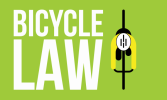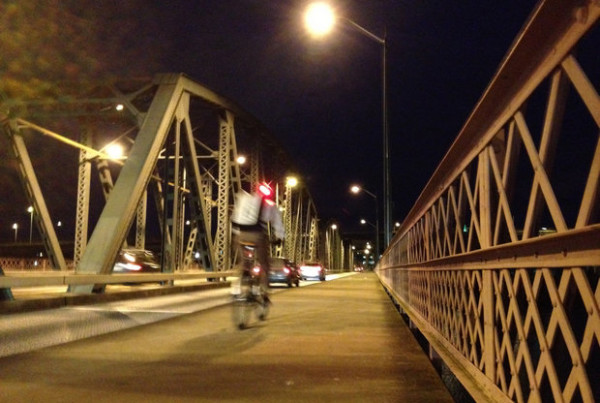THE NEW YORKER: RATIONAL IRRATIONALITY- BATTLE OF THE BIKE LANES
MARCH 8, 2011
Posted by John Cassidy
At the risk of incurring the wrath of the bicycle lobby, a constituency that pursues its agenda with about as much modesty and humor as the Jacobins pursued theirs, and which has found its heroine in transportation commissioner Janette Sadik-Khan, I say hats off to Iris Weinshall, the former transportation commissioner (and wife of Senator Chuck Schumer), who, together with some like-minded citizens, has filed a lawsuit challenging a bike lane on Prospect Park West.
Tuesday’s Times said the lawsuit, which was filed Monday in State Supreme Court, calls on the city to remove the controversial green tarmac, citing a state law that allows citizens to challenge arbitrary and unfair actions by the government. The lawsuit concerns just one stretch of road. If successful, however, it could open the way to a broader challenge to City Hall, which sometimes seems intent on turning New York into Amsterdam, or perhaps Beijing.
I don’t have anything against bikes. As a student, I lived in the middle of Oxford, where cycling is the predominant mode of transport, and I cycled everywhere. Twenty-five years ago, when I moved to the East Village, I paid a guy on Second Avenue thirty dollars for a second-hand racing bike (probably stolen). Of a Sunday afternoon, hungover from the previous night’s carousing at neighborhood bars and clubs, I would pedal furiously up First Avenue, cross over to Park or Madison, continue up to Central Park and then race back down Fifth, all the way to Washington Square. In those days, there were few cyclists on the roads, and part of the thrill was avoiding cabs and other vehicles that would suddenly swing into your lane, apparently oblivious to your presence. When I got back to my apartment on East 12th Street, I was sometimes shaking.
Today, of course, bicycling is almost universally regarded as a serious, eco-friendly mode of transport, and cyclists want it easy. From San Francisco to London, local governments are introducing bike lanes, bike parks, bike-rental schemes, and other policies designed to encourage two-wheel motion. Generally speaking, I don’t have a problem with this movement: indeed, I support it. But the way it has been implemented, particularly in New York, irks me to no end. I view the Bloomberg bike-lane policy as a classic case of regulatory capture by a small faddist minority intent on foisting its bipedalist views on a disinterested or actively reluctant populace.
The bitter rant of an angry motorist? Perhaps. Since 1989, when I nervously edged out of the Ford showroom on Eleventh Avenue and 57th Street, the proud leaser of a sporty Thunderbird coupe, I have owned and driven six cars in the city, none of which could be classed as a fuel-economy vehicle: the Thunderbird, a Mercedes E190, an ancient Oldsmobile Delta 88 that could have done double duty as a paddle steamer on the Hudson, two Cadillac Sedan de Villes, and (my current heap) an old Jaguar XJ6.
All of these vehicles I have used for work purposes and for domestic and leisure trips. Most of the time, I have parked them on the street, an urban custom the utility of which only becomes manifest when it is absent. Thanks to these four-wheel friends, I have discovered virtually every neighborhood of the city and its environs, and I would put my knowledge of New York’s geography and topography up against most native residents—cycling members of the Park Slope food co-op included. Today, with two young children who need ferrying hither and thither, I still drive all over town—and take great enjoyment out of it.
Undoubtedly, during all those years, I should have been paying higher gas prices to cover the putative costs of cleaning up the carbon emissions I was creating, but that doesn’t diminish an important point: Americans love their cars for good reason. They are immensely useful and liberating contraptions.
Part of my beef, then, is undoubtedly an emotional reaction to the bike lobby’s effort to poach on our territory. But from an economic perspective I also question whether the blanketing of the city with bike lanes—more than two hundred miles in the past three years—meets an objective cost-benefit criterion. Beyond a certain point, given the limited number of bicyclists in the city, the benefits of extra bike lanes must run into diminishing returns, and the costs to motorists (and pedestrians) of implementing the policies must increase. Have we reached that point? I would say so.
A minor but not completely insignificant example. Like many New Yorkers who don’t live in Manhattan, one of my favorite pastimes is to drive from Brooklyn, where I live, into the city for dinner and find a parking space once the 7 A.M.-7 P.M. parking restrictions have lapsed. Years ago, this was a challenge, but a manageable one. These days, especially downtown, it is virtually impossible. When the city introduces a bike lane on a given street, it removes dozens of parking places. All too often these days, I find myself driving endlessly up and down Hudson, or Sixth Avenue, or wherever, looking in vain for a legal spot—and for cyclists. What I see instead is motor traffic snarled on avenues that, thanks to bike lanes, have been reduced from four lanes to three, or three to two. As of old, I sometimes almost run into a delivery boy riding the wrong way down the street, but even the delivery boys don’t seem to use the bike lanes for this purpose. (Perhaps they, too, are frightened of incurring the righteous rage of the helmeted.)
Mayor Bloomberg, who plays Robespierre to Sadik-Khan’s Saint-Just, is forever claiming that, thanks to his enormously popular policies, bicycle usage has doubled, tripled, or quadrupled. Maybe that’s true in some places—there are a lot of bikers in Prospect Park these days, I grant you—but in Midtown? The Village? The East Side? I don’t see them. Even in Brooklyn, home to some of the most ardent bike activists, bike lanes have been overdone. Take Third Avenue* in Gowanus, a thoroughfare that abuts the sacred Slope but which is itself still largely a commercial route. When I drive up and down Third Avenue, as I do often, what I usually see are cars and trucks inching along in single file (it’s a two-way street) with an empty bike lane next to them. (On those rare occasions when I do happen across a cyclist, or two, he or she invariably runs the red lights.)
So, by all means, let us have some bike lanes on heavily used and clearly defined routes to and from the city—and on popular biking routes within the city and the boroughs. But until and unless there is a referendum on the subject—or a much more expansive public debate, at least—it is time to call a halt to Sadik-Khan and her faceless road swipers.
Just perhaps, in Weinshall, the unstoppable force has met an immovable object. As somebody who served in the very post Sadik-Khan holds for almost seven years (September 2000 to April 2007), Weinshall can hardly be described an as enemy of cyclists. During her tenure as transportation commissioner she oversaw a significant expansion of bike lanes, including routes to and from Brooklyn. But now, apparently, Weinshall has had enough. In her lawsuit, according to the Times, she is promising to expose the cozy relationship between officials and bike activists as well the dubious statistics that the city uses to justify its policies.
Like many New Yorkers, I will be quietly cheering her on!

